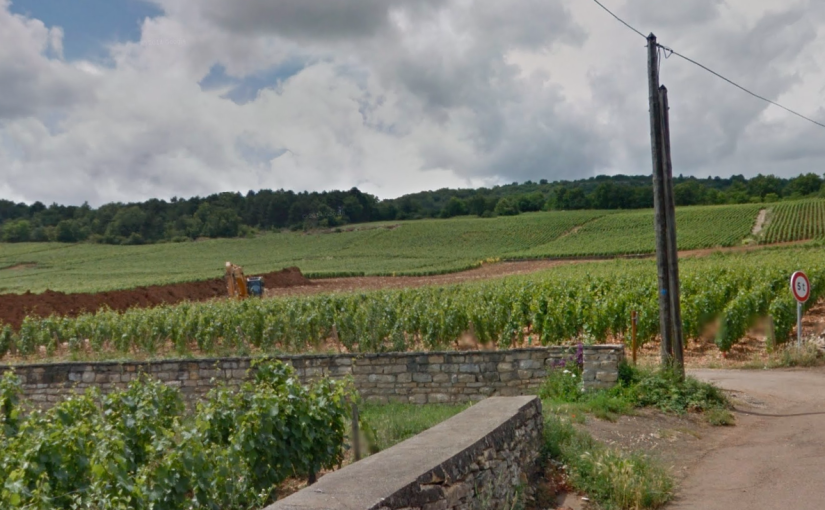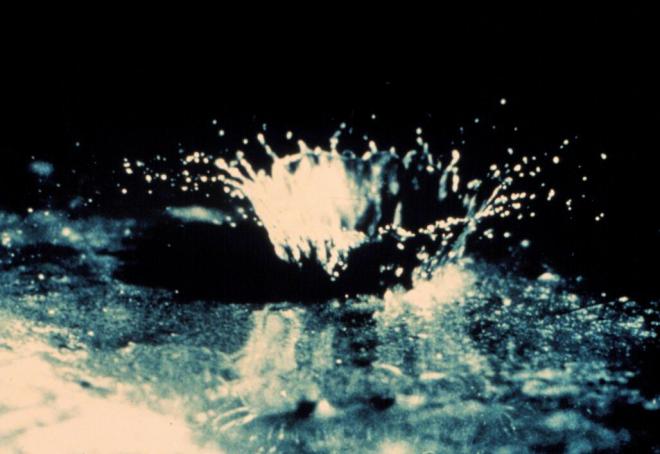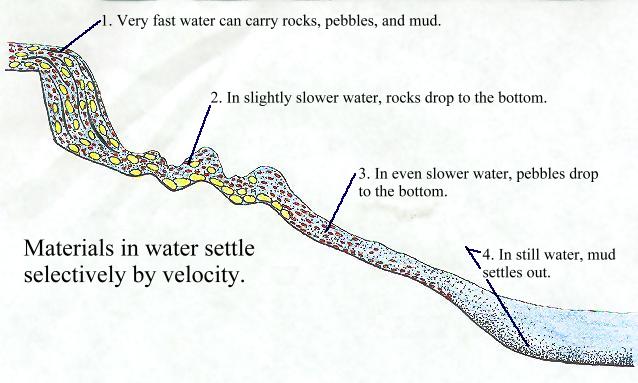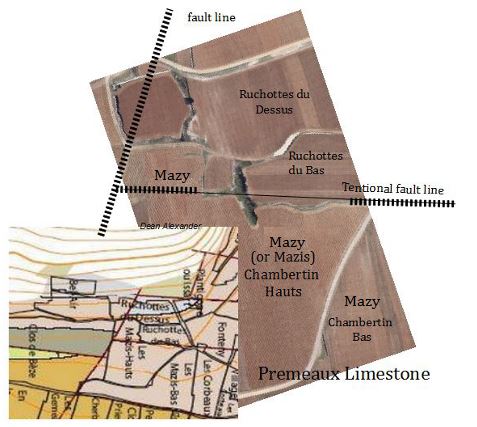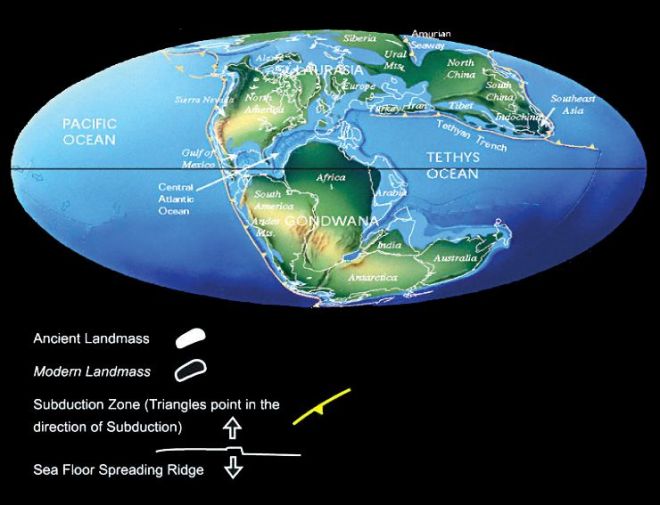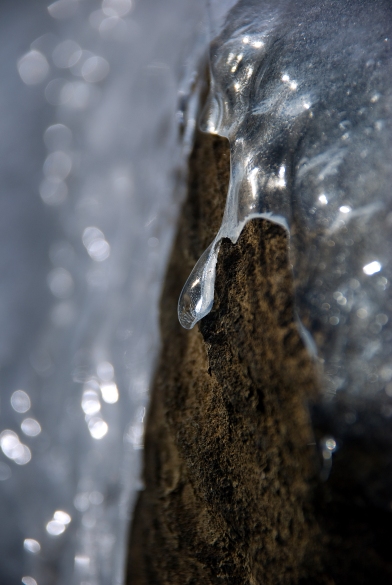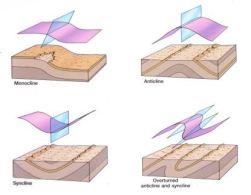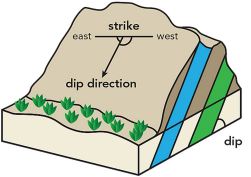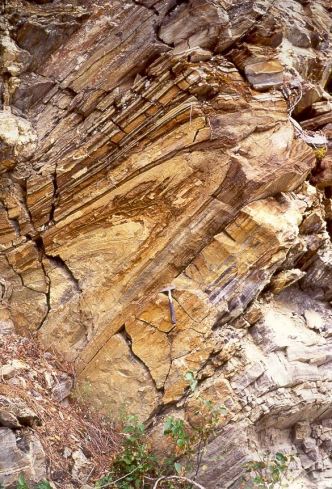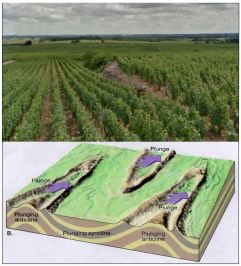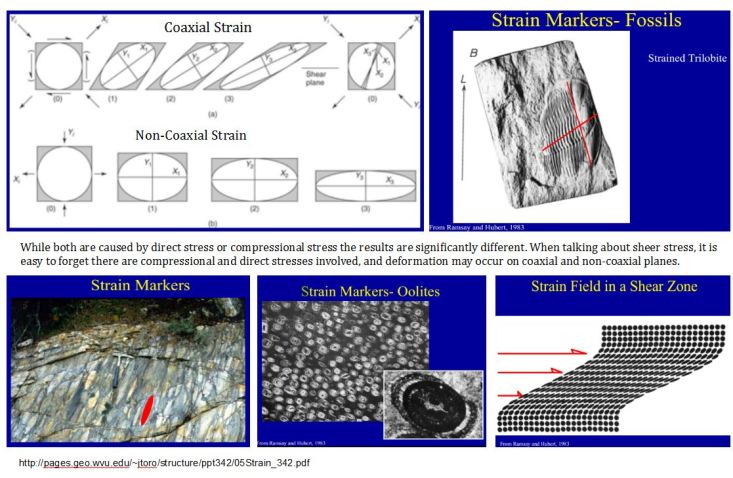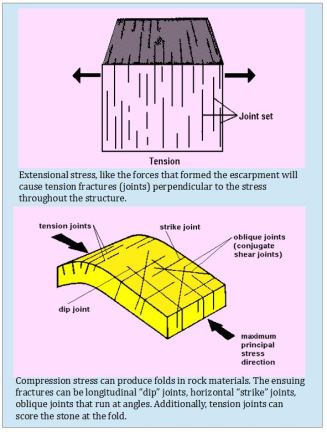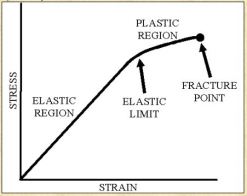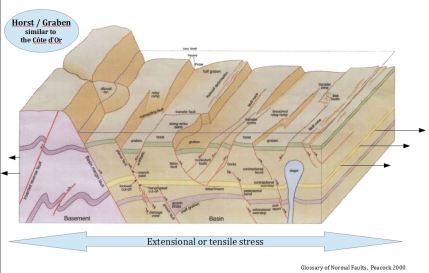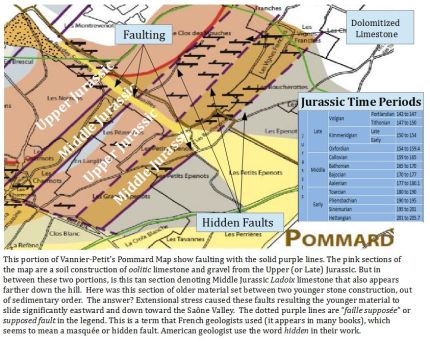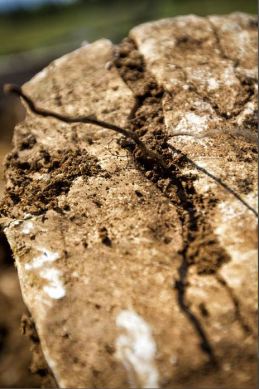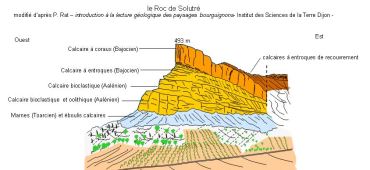Ancien Régime
A historical explanation for Les Damaudes’ retention of clay

Changes in parcel division and parcel orientation
While there is no specific information regarding the history of Les Damaudes prior to 1952, the cadastre map of 1827* indicates that the vineyard was planted to vine at that time and that it’s division and orientation was very different in 1827 than it is today. This map indicates that at some point between 1927 and 1952, there was a total reorganization of both parcels and ownership. This reorganization also suggests that the owners of the parcels had abandoned this land. Had there been a continuity of ownership, there would be at least some continuity of plot divisions. Instead, the study plot cleaves through multiple plots shown in the 1927 cadastre.
The Ouvrée, the balk, and soil preservation
Many of the plots indicated by the map, were very small. The size itself is indicative of ownership by peasant farmers. These small parcels were the remnants of the ancien régime; the open field system that created and dictated the agricultural fabric of France for over seven centuries. At the time of the revolution, a full third of Burgundian agricultural land was farmed under the manorial system and was converted to peasant ownership. (Loutchisky 1911)
Additionally, some of the larger parcels of Les Damaudes were oriented horizontally to the slope, so the rows followed the hillside. These parcels were large enough and long enough to suggest they may have been plowed. These larger plots were traditionally sized by the amount land a man could work in a day with a pair of plow animals, were measured in ouvrées.(1) These larger plots, with their long, narrow horizontal orientation would not have allowed nearly the high rate of erosion as similarly sized vertical plantings of today do. Secondly, because these horizontal plots were relatively narrow, erosion was again curtailed, as storm water runoff would have been slowed by these closely spaced divisions.
All across Europe, serfs and villeins (freeman tenants) (2) tended their plots, known as selions, just as they had for over seven centuries. Selions were traditionally divided by a raised, strip of fallow land called a balk indicating the end or beginning of one man’s plot and the beginning of another. The word balk (to pause or not proceed) originated from this practice of plot division.
Any break in vineyard planting, like plot divisions, roads, and walls, all have been shown to slow runoff by diminishing its velocity, thus easing the pressures of erosion. So the small size of these parcels alone would have deterred erosion, but if these plots were additionally bordered by any kind of balk, these would obstacles would have minimized the velocity of the runoff. There is evidence that balks did exist in Burgundian vineyards, as Jim Busby Esquire. describes walking along “grassy footpaths” while visiting the vineyard of Chambertin in 1840. It is reasonable to conclude the small parcel divisions of Damodes, each likely separated by a balks or footpaths, were huge contributors to the fact that such a high percentage of clay was retained in this steep vineyard.
One foot in feudalism
At the time of the Revolution, feudalism, although waning, still existed in various forms. So on the heels of the French Revolution in 1789, when the National Assembly released all of the demesne (domaines) of King Louis XVI, the serfs and freemen tenants who farmed these lands were given the title of the plots they had farmed before the Revolution. This action would affect a quarter of the farmland in France, although in Burgundy this figure was higher. The royal demesne constituted 35% of the agricultural land in Burgundy at the time of the revolution, while it is estimated that church held the title of an additional 11% to 15% (Loutchisky 1911). This acts also released France’s 150,000 serfs, almost all of which had belonged to the Church. (Sée 1927)
Initially, the peasants were to pay for the release of seigneurial dues, but as the peasants could not pay with money they did not have, these release fees were withdrawn by the National Assembly in 1793. With a mere 38 years separating the revolution and the production of the 1827 cadastre map, it is likely that some of the owners of these plots had been former villien (freeman tenants) and were still working plots they had gained because of the revolution.(3)
*For additional explanation of feudalism see Part 4: The history of erosion and man.

Although they were now landowners, rather than landholders, the peasant’s lot had not significantly changed. The wealthiest of them could earn a living off of the land as farmers, either on their own or in co-op with others as métayers. Many continued to struggle for sustenance, working also as day laborers, or worked a side trade (Henri Sée 1927).
In some ways, many of farmers were to be worse off for it for the dissolution of the feudal system, which through its evolution, had allowed significant freedom, and did not generally entail servitude. Additionally, the dues owed by the tenant farmers were far less burdensome than they had been in the middle ages, consisting of rent and a few days of compulsory labor on the nobles demesne (Sée 1927). Within this feudal framework, the Seigneur provided communally shared horses and plows, which all laborers used to make the work their fields.
With the removal of the feudal system, the peasant needed to provide his own tools, and that included the use of any plow animal.
A pair of oxen cost 300 to 400 francs at the time Busby visited France in 1840, and for all but the wealthiest peasants, this was an unfathomable price to pay for an animal. Plows were also an expensive piece of equipment. Since a man with a pair of plow animals could work roughly six to eight times the area, than a man without one, the loss of access to a horse and plow predictably would have significant implications for the peasant farmer. They now must attempt to use a shovel and hoe to try to farm the same area of land they had as a villein using the seigneur’s horse and plow. This loss of productivity (in terms of area) would require the peasants to either hire workers to help work their fields or sell (or lease) land they were not physically able to work by hand. If there was a positive side to this, having to hand-work these small plots was an additional factor in the preservation clay in the vineyard of Les Damaudes.
24,000 or more vines per hectare
It was either the small size of plots or the inability to buy plow animals (or both), that encouraged Burgundy’s farmers to literally fill every empty space of a vineyard with vines. It was common at the time, for Burgundian vineyards to achieve planting densities of 24,000 to 30,000 vines per hectare.
When visiting the great vineyard of Chambertin, James Busby recorded that in the half-hectare plots there, a mere 15 inches of spacing existed between each vine. This was true not only between plants within a single row but between rows as well. Busby wrote that “The plants were literally crowded to such a degree, that it was almost impossible to set down the foot without treading upon some of them.” It would be seemingly impossible to plow a vineyard with such spacing, which meant all vineyard work would have to be accomplished with a hoe.
 The peasant would achieve this enormous number of vines, essentially for free, by a technique called layering or provignage. This was the poor man’s answer to using cuttings, which were by then, being bred in nurseries from clones scientist had discovered to be resistant to various diseases. The cuttings were however very expensive and often used sparingly even by more wealthy land owners, only one cutting used for every three vines established. The other vines would be grown via provignage from the purchased cutting.
The peasant would achieve this enormous number of vines, essentially for free, by a technique called layering or provignage. This was the poor man’s answer to using cuttings, which were by then, being bred in nurseries from clones scientist had discovered to be resistant to various diseases. The cuttings were however very expensive and often used sparingly even by more wealthy land owners, only one cutting used for every three vines established. The other vines would be grown via provignage from the purchased cutting.
To perform layering or provignage, a trench was dug from a healthy plant to the location where the farmer wanted to establish a new plant. He would then bury a cane or shoot of the vine into the furrow he had dug, with a layer of manure and then cover this with soil. Over the course of the next year, the buried cane (shoot) would develop roots of its own, and the vigneron would separate the two vines by cutting off the cane that started the new plant. Alternately, the two vines could be left adjoined, and in many places, there could be several of these Siamese vines connected to one another. The vineyardist would attempt to regulate the rows to be as straight as possible, but layering created such irregularity that Busby recalled that “it would have been very difficult to point out which way the alignment lay. For this purpose, the stocks and roots were twisted, and the different plants laid across each other in every possible direction.”
“for a poor man, the game, or, as it was generally called, the large plant, was undoubtedly the best kind of vine, the quantity it yielded was so much greater than the other; and, to a poor man, the quality was not so much an object, for the large proprietors and merchants would never acknowledge his wine to be a fine one, and it was very difficult to sell it for a high price, however good.”
Journal of a Recent Visit to the Vineyards of Spain and France, James Busby Esq. 1840
According to Busby, a plant grown by provignage would produce grapes in its first year. However, the vines would become weak in 10 to 15 years time and would need to be replaced. This meant the 19th-century vineyard was in constant state tearing out and replanting. In vineyards such as Chambertin, which produced exponentially more expensive wine, the vineyard owner could often afford lay fallow sections in which vines were removed. These fallow areas were then planted to sainfoin, a cover crop that could be used to feeding horses, while simultaneously rejuvenating the soil with nitrogen that had been depleted by overcrowding the field (domaine in French) with vines. This alternate use would last for four years, and represented a significant cost, and could only be sustained by a vineyard that produced a wine that fetched high prices in the marketplace. This would not have been true of a vineyard such as Les Damaudes.
It is clear, that as of 1860, there were many vineyards in which the soils were still in relatively good shape, because of the farming methods of the time. There has been some historical record of vineyards, as early as the 1600’s, that required their soils to be replaced, (presumably due to rill and gully erosion) to cover exposed base rock. The tremendous expense of bringing in soils indicates that this erosion occurred in larger vineyards owned by a wealthy marquis or another nobleman, the church, or later, a member of the growing bourgeoisie, who would dominate the
 This set the stage for the introduction of phylloxera to France and Burgundy. It would be too simple of a story to phylloxera wiped out the vineyards of France and eventually the vineyards were replanted with root-stock from American hybrids. While most accounts of the phylloxera blight in terms of total dollars lost and businesses going under; as in all economic downturns, there are those who lose everything, and those losses create opportunities for others. And that is the story of Les Damaudes. We know there was a wholesale change of plot ownership and re-organization parcel disbursement in the vineyard, that occurred sometime between 1827 and 1952. While precisely when and how remains a mystery, but there is no doubt that phylloxera played a large role in this story.
This set the stage for the introduction of phylloxera to France and Burgundy. It would be too simple of a story to phylloxera wiped out the vineyards of France and eventually the vineyards were replanted with root-stock from American hybrids. While most accounts of the phylloxera blight in terms of total dollars lost and businesses going under; as in all economic downturns, there are those who lose everything, and those losses create opportunities for others. And that is the story of Les Damaudes. We know there was a wholesale change of plot ownership and re-organization parcel disbursement in the vineyard, that occurred sometime between 1827 and 1952. While precisely when and how remains a mystery, but there is no doubt that phylloxera played a large role in this story.

When phylloxera arrived on the doorstep of the Côte d’Or in 1775, it was clear that a peasant would not be able to withstand the loss of their vines. The peasant, who depended on every Franc for their day-to-day survival, could not afford the chemicals to treat the vines. They could in no way spend a year’s labor tearing our their vineyard. This was an impossibility. And they certainly could not afford the 3000 Francs per hectare it cost in 1880 to replant the vineyard. It almost seems silly at this point to mention they would not be able to afford to labor in the vineyards for the four years that the young vines would produce no fruit. If they were lucky they would own other plots of land that produced produce or wheat that could sustain them. Otherwise, these peasants were likely many of the 1 million Frenchmen who would emigrate to Algeria or America in the 1870’s through 1900.
Ironically, as the grape growing peasantry was forced to leave their land in phylloxera affected areas, economically, in France, things were improving. For the unskilled worker, wages increased 2/3’s between 1850 and 1910. During the same period, GDP doubled, despite France’s involvement in the Crimean war and the disastrous Franco-Prussian war of 1870 which saw the fall of the Napoleon III and the second Republic. Likely, it was France’s continued imperial pursuits of colonizing parts of Africa and Asia artificially buoyed they French economy, but whatever the reason, the economic up-turn caused a growth in demand for wine and rising prices, and this promise of demand would justify replanting the most profitable of vineyards immediately.
Hopefully, this long, historical explanation of why the soils of Les Damaudes (and likely those in Cros Parantoux) retained their natural levels of clay, may seem reasonable. In my view, the retention of clay was two-fold. Number one: the vineyard was farmed in small divided sections, and farmed by hand. Additionally, the larger parcels were oriented horizontally, limiting the distance between plots on the vertical axis. These larger plots or may not have been plowed in the 1800’s; but if they were, because of the plot shape, could only have been done across the slope, following the curve of the hillside. This would have limited erosion. Secondly, like Cros Parantoux, this vineyard likely lay abandoned for a lengthy enough period that ownership of the vineyard was reapportioned. The most obvious period for this to have happened was from the early 1880s when phylloxera struck to 1952 when this parcel was planted.
I defer to Steen Öhman author of winehog.org, who has carefully researched the available history – primarily ownership – of Cros Parantoux . Read his article here.
(1) The Burgundy Report has a breakdown of land that is significantly different than found in the book, Measures and Men Witold Kula Princeton University Press (1986). Bill Nasson reports that an “Ouvrée is 4.285 ares; the area one man could work in one day” and a “Journal equals 8 ouvrées, or 860 perches, or 81.900 ares and was the area one man could work in one day with a horse and plough.” This is very different than Kula’s writing that an ouvrée was a vineyard specific measurement that Burgundian used for the area that a man could work with a pair of plow animals, and a journeaux in Burgundy referred specifically to the size of a cornfield a man could work with a pair of plow animals. I was unable to find further supporting evidence for either account.
(2) Serfs of France had largely been “enfranchised” over the course of the middle ages. But this varied on where and when since control of France was spread over various Duchies. To give a general time frame when enfranchisement was occurring, Charles the Fair emancipated the serfs of Languedoc in two letters from 1298 and 1304. Upon gaining freeman status, serfs became villeins (this is where the word villain came from, meaning: scoundrel or criminal). They may have been enfranchised but in many ways, their situation had not changed all that significantly. As tenant farmers, they were still legally bound to the manor where they were tenants. They paid ‘rent’ either in the form of money or produce, and owed the noble of the manor a certain number of days of unfree labor each year, referred to as Corvée. This was simply a form of barter between the tenant and the nobleman. A similar arrangement is the sharecropping agreements referred to as métayage, meaning half. This is another form of barter agreement, where the lease payment is in the form of a percentage of the product of the vineyard, in either grapes or wine.
(3) The life expectancy in France in 1828 was 37 years, thanks in part to the smallpox vaccinations that began in 1810. Earlier, in the 18th century half of all children died before the age of 10 years old, lowering the average life expectancy in the 1700’s to only 25 years. The period of the Napoleonic Wars, 1803 to 1815, saw a drop in average age to below 30 years. This happened again in 1870 following the disastrous (for France) Franco-Prussian, when the Napoleon III was captured, and Paris would later fall Germans January of 1871, in Bismark’s successful bid for German unification.
Additional reading
A History of French Public Law, Volume 9, Jean Brissaud p. 317-318 Ulan Press (1923)
Economic and Social Conditions in France During the Eighteenth Century Henri Sée Professor at the University of Rennes 1927
http://press.princeton.edu/chapters/s9479.pdf European Wine on the Eve of the Railways, James Simpson


